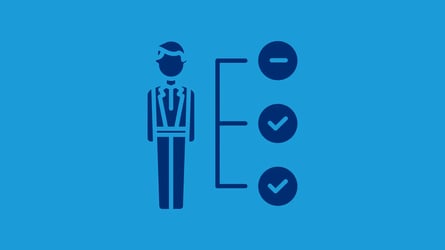What is event marketing and why is it important to brands?
Event marketing is a strategy commonly used by marketers to promote a brand, product, service or a cause through real-time engagement. It involves gathering an audience of certain demographics or with shared interests. Regardless of how diverse the target audience might be, events share a common objective: to engage attendees as well as existing and potential customers.
Events are a great avenue for marketers to build brand awareness and win the trust of prospective buyers and customers. It’s never just a logo advertisement but a strategic mix of offline and online brand building initiatives where you create a space for your audience to engage with your brand.
Depending on your objectives, it could be a good opportunity to generate new leads, launch a new product or offering, or boost brand recognition amongst your audience. Additional value from events could also be generated from media coverage and brand engagement, which extend beyond the live event.
The key to making events work as part of your marketing strategy also relies heavily on knowing who you want to reach and being able to identify which events your target audience is attending.
What type of events work for your brand
Let’s wear the consumer hat for a moment here. Now, think back to the events you attended recently. Was it a seminar, a product launch, or a marketing conference? Perhaps a music festival or the Formula 1 Grand Prix?
Events come in different forms and sizes. You could be hosting your own event or sponsoring one that resonates with your brand. Depending on how big an event is, the marketing budget and potential reach usually scale with it.
Then the question follows: as a marketer, how do you actually track the brand engagement as a result of hosting or sponsoring an event?
Let’s take Formula 1 Grand Prix for example
Every year, fans around the world gather in anticipation of the Formula 1 Grand Prix, a premier motor race. According to official reports, over four million attended at least one of the 2018 Formula 1 Grand Prix events in one of the 21 cities/venues.
The race calendar spans from March to November 2018 and the countries with the most number of attendees (>200k race average) last year were:
- Great Britain
- Mexico
- Australia
- United States of America
- Singapore
- Belgium
- Hungary
A simple Quick Search shows over 16 million mentions about Formula 1 during that period where the most used hashtag was #F1 with 5M mentions, and each of the top countries’ hashtags had over 290k mentions each.

Number of mentions for the top 7 countries with the most number of attendees last year.
Given Formula 1’s massive reach, there’s no doubt it’s a magnet for investment from brands, which come in the form of sponsorship as well as specialist resources. The sports cars used in F1, for instance, are built specifically for the race by brands like Ferrari, McLaren, and Mercedes.
It’s a perfect example of how a live event can generate so much coverage and conversation from social media, to forums, news, and blogs.
Australian Grand Prix 2019
The 2019 Formula 1 Grand Prix just kicked off in Melbourne. Over 213k mentions were generated on the race day, 17th of March. We can track 9.8 million in engagement for a period of 30 days.
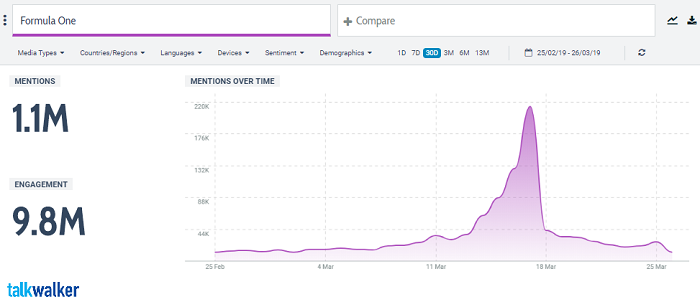
Mentions & engagement around Formula One from 25 February to 25 March 2019.
About 97% of these 213k mentions originated from outside of Australia, which shows us how much conversation is generated about the race, globally, and the potential exponential reach participating brands can have from such an event.
For brands seeking to build awareness and connection with prospective buyers and customers of these demographics, F1 Grand Prix could be a good opportunity to reach them.
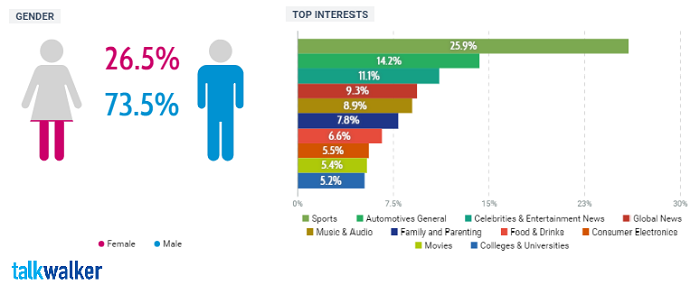
Audience demographics from the Formula One from 25 February to 25 March 2019.
Then, the question follows: how do you track the social mentions during an event to analyse the impact of your participation?
In this post, we’ll share some tips on how you can get some answers with Talkwalker Quick Search.
What is Quick Search and how to use it to track social mentions during an event?
Quick Search, as the name suggests, is a fast way to get insights about a certain topic - be it a campaign or your brand in general.
In the context of an event, the tool can help you measure brand engagement and media coverage, and understand the reach of your brand’s participation in the event.
For this example, we could look at luxury watch brand Rolex, the title sponsor of the Formula 1 Rolex Australia Grand Prix. If we’d like to get a sense how far along the reach of Rolex’s participation in F1 is, we can use Quick Search to track social mentions of the Rolex brand during the Grand Prix.
Step 1 Initiate a Quick Search
Identify key terms used in the event such as event names and acronyms as well as hashtags. For example, Formula 1 is also referred to as Formula One, Formula 1 Grand Prix, F1, and more. On top of that, each of the host cities has its own official hashtag.
From there, you can add the key terms and hashtags related to your brand.
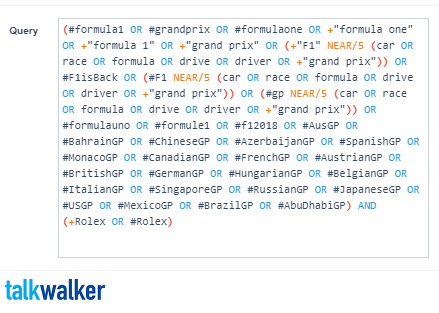
Sample topic setup using Quick Search
Step 2 Track the mentions and engagement
In this example, the view is set to a 30-day window to see exactly when the conversation started to pick up. Rolex was mentioned over 10,000 times as a result of their sponsorship and 40% of these mentions were generated on the race day itself.
Here's the top tweet posted by the official @F1 Twitter account that got 9.2k in engagement and 3.8 million in potential reach.
Fair to say @redbullracing and @HondaRacingF1's first date went well
One race, one podium in the bag thanks to @Max33Verstappen's move #AusGP #F1 pic.twitter.com/2cq0TekFam
— Formula 1 (@F1) March 17, 2019
The post didn’t even mention Rolex in the caption but still quite prominently show the Rolex logo boosting brand visibility. Thanks to new video recognition technology, it’s finally possible to track brand mentions in videos.

Rolex brand mention tracked in F1 race video
If one of your goals for this event is to generate media coverage, you can also check exactly how many mentions you got from news and blogs. This example shows us that Rolex was mentioned in news and blogs over 1,600 times, which generated 40.1k in engagement.
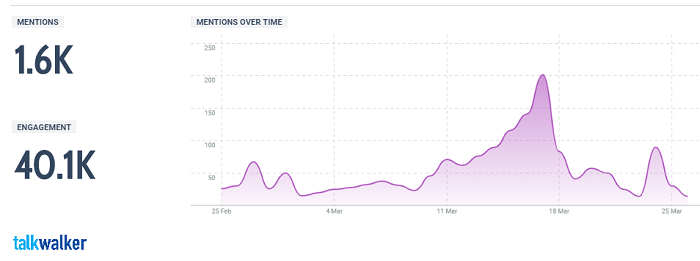
The Rolex brand was mentioned 1.6k times in news & blogs related to F1 25 February to 25 March 2019
Step 3 Generate a post-event report tracking social mentions
One of the best parts about using a tool like Quick Search is being able to generate a report with all the key metrics relevant to tracking social mentions during your event. With just a few clicks, you can generate a post-event report to share with your team. Great job!
Conclusion
Your event marketing efforts ultimately depend on how much you capitalize on both the offline and online aspects of the event. By having a well-defined goal, you would know better how to leverage both in-person and online activities, and maximize the return of your investment. This simple guide will give you some tips and ideas on how you can better measure the impact of your event marketing strategy by tracking social mentions related to the event.

